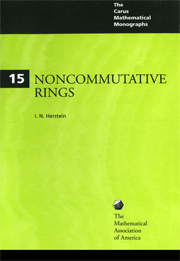2 - SEMISIMPLE RINGS
Summary
The aim in defining the radical was to concentrate the bothersome behavior of a ring in a piece of it such that when this piece was removed the resulting ring was well enough behaved to permit some delicate dissection. The guidelines we choose for this dissection are the beautiful theorems of Wedderburn for the case of Artinian rings.
The success of this scheme is capable of a somewhat objective measure in the results that eventually come forth. We now undertake a more minute study of semisimple rings. In the material developed we shall provide ourselves with an assortment of instruments to attack general ring-theoretic questions, questions in whose hypotheses the derived concepts of radical, semisimplicity and the like play no role, but in whose solutions they enter intimately.
As often as possible we shall specialize the theorems obtained to study their implications in the classical case, obtaining thereby many well-known results.
The density theorem. We begin with a basic concept in the structure theory of rings. The special rings we introduce play the analagous role for general semisimple rings as that played by simple rings in the Artinian case.
Definition. A ring R is said to be a primitive ring if it has a faithful irreducible module.
Such a ring should really be called right primitive for all modules used are right modules. We could similarly define left primitive rings.
- Type
- Chapter
- Information
- Noncommutative Rings , pp. 39 - 68Publisher: Mathematical Association of AmericaPrint publication year: 1968



